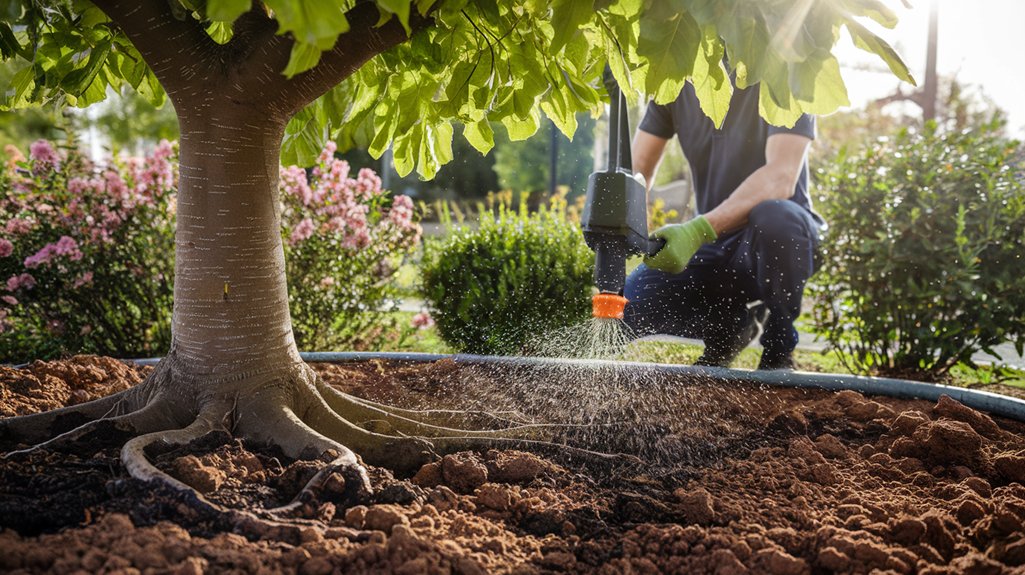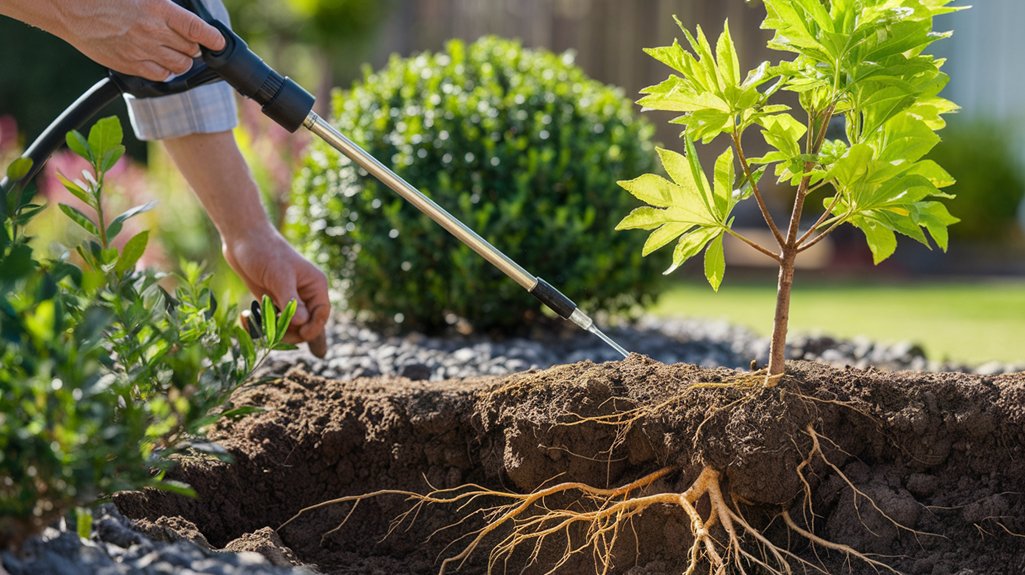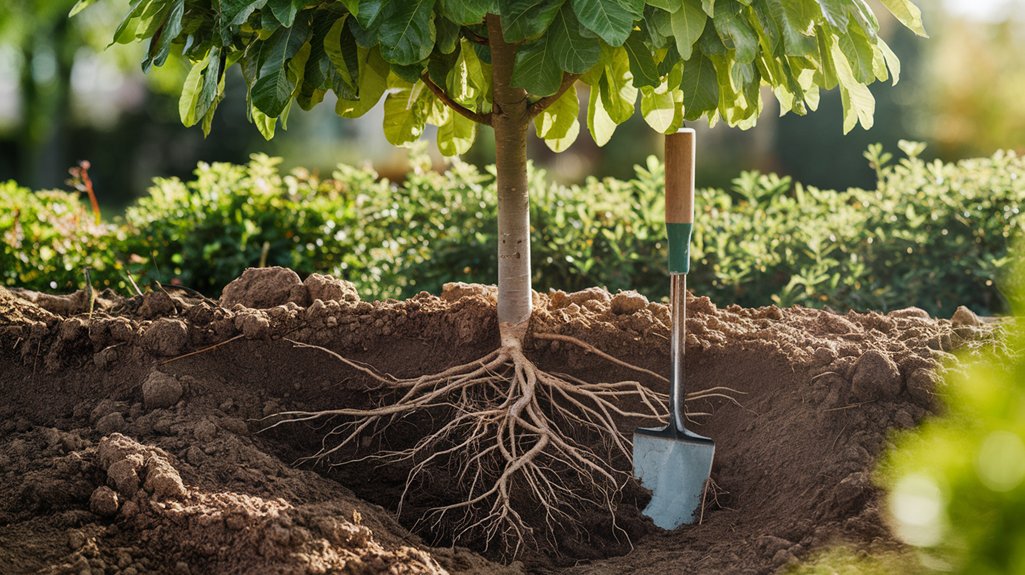If you want your trees and shrubs to thrive, understanding deep root feeding is crucial. This technique directly nourishes their root systems, helping them grow stronger and more resilient. It's not just about watering—there's a method to it. Knowing when and how to apply this practice can make a significant difference in your garden's health. Curious about how to get started and what nutrients your plants really need?
Key Takeaways
- Deep root feeding directly delivers nutrients to the root zone, enhancing tree and shrub health and growth.
- It improves soil structure and encourages beneficial microbes, promoting overall soil health.
- Performing deep root feeding during active growth seasons maximizes nutrient absorption and plant resilience.
- Proper nutrient selection based on soil testing ensures plants receive the specific support they need.
- Avoiding common mistakes, such as overwatering and incorrect nutrient ratios, enhances the effectiveness of deep root feeding.
Understanding Deep Root Feeding

Deep root feeding is a vital technique for nurturing trees and shrubs, ensuring they receive essential nutrients deep within the soil.
By targeting the root systems directly, you help plants thrive despite challenges like soil compaction, which can restrict their growth and nutrient uptake. This method involves delivering nutrients through deep holes drilled into the soil, allowing them to reach the roots where they're needed most.
When you apply this technique, you encourage healthy root development, enabling trees and shrubs to draw moisture and nutrients more effectively. It's a proactive approach that fosters resilience against environmental stressors.
Understanding deep root feeding can transform the health of your landscape, ensuring your plants flourish year after year.
Benefits of Deep Root Feeding for Trees and Shrubs

By implementing deep root feeding, you unlock numerous benefits for your trees and shrubs. This method significantly enhances tree health by delivering essential nutrients directly to the root zone, where they're most needed.
You'll notice improved nutrient absorption, allowing your plants to thrive and grow stronger. Healthy trees and shrubs are more resilient against pests and diseases, reducing the need for chemical treatments.
Additionally, deep root feeding promotes better soil structure, encouraging beneficial microbes to flourish. This creates a more balanced ecosystem around your plants.
Ultimately, your landscape will flourish, showcasing vibrant foliage and sturdy growth. Investing in deep root feeding is a smart choice for any homeowner looking to maintain and enhance their outdoor spaces.
When and How to Deep Root Feed

Timing and technique are crucial when it comes to deep root feeding, as they can significantly impact the success of your efforts. The best practices suggest performing this task during the spring or early fall when your trees and shrubs are actively growing. This seasonal timing allows the roots to absorb nutrients effectively.
Start by identifying the root zone, usually extending to the tree's drip line. Use a soil auger or a garden fork to create holes about 12-18 inches deep, spaced evenly around the base.
Apply your chosen nutrient solution slowly into these holes, ensuring it reaches the roots. Water the area thoroughly afterward to help distribute the nutrients. Following these steps will enhance your plants' health and resilience.
Choosing the Right Nutrients for Your Plants
After preparing the soil for deep root feeding, selecting the right nutrients becomes vital for maximizing the benefits of your efforts.
Start by conducting soil testing to determine which nutrients your trees and shrubs need most. This helps you identify any deficiencies and ensures you're providing the right nutrient sources.
Common nutrients include nitrogen, phosphorus, and potassium, each playing a crucial role in plant health.
You might consider organic options like compost or well-rotted manure, which enrich the soil naturally.
Alternatively, synthetic fertilizers can provide quick results but should be used carefully to avoid over-fertilization.
Common Mistakes to Avoid in Deep Root Feeding
While deep root feeding can significantly benefit your trees and shrubs, several common mistakes can undermine your efforts. Here's what to avoid:
| Mistake | Explanation | Solution |
|---|---|---|
| Overwatering Issues | Too much water can drown roots. | Water only as needed. |
| Nutrient Imbalances | Incorrect nutrient ratios harm plants. | Test soil and adjust nutrients. |
| Timing Missteps | Feeding at the wrong season can stress plants. | Feed during active growth. |
| Improper Depth | Nutrients must reach roots effectively. | Ensure proper depth when feeding. |
Frequently Asked Questions
Can Deep Root Feeding Harm Established Trees and Shrubs?
Yes, deep root feeding can pose risks to established trees and shrubs. If done improperly, it might disrupt root systems or introduce excess nutrients, negatively impacting tree health. Always ensure proper technique to minimize potential harm.
How Often Should I Deep Root Feed My Plants?
You should deep root feed your plants every one to three years for optimal feeding. Adjust the deep root frequency based on your plants' health, soil quality, and specific needs to ensure they thrive.
Is Deep Root Feeding Effective for All Tree Species?
Not all tree species have the same compatibility with deep root feeding. While many benefit from it, some may show limited nutrient absorption effectiveness. Always research your specific tree species to ensure optimal results.
What Signs Indicate a Need for Deep Root Feeding?
You'll notice signs like yellowing leaves, stunted growth, or poor flowering when your trees need deep root feeding. These indicate nutrient deficiency, signaling that enhancing root health could revive your plants and promote their vitality.
Can I Deep Root Feed During Winter Months?
You can deep root feed during winter months, but it's best to wait until trees are fully dormant. Winter feeding helps nourish them, but ensure the ground isn't frozen, as that can hinder nutrient absorption.
Conclusion
In conclusion, deep root feeding is a game-changer for your trees and shrubs. By directly nourishing their root systems, you can boost their growth and resilience against pests and diseases. Remember to time your feeding right and choose the appropriate nutrients for your plants' needs. Avoid common mistakes, and you'll set your greenery up for long-term health and vibrancy. Start deep root feeding today, and watch your plants thrive like never before!
